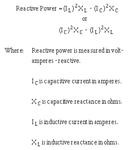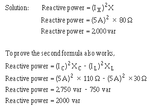danishdeshmuk
Advanced Member level 1
How we classified resistive , capacitive & inductive loads ?
What are advantages & disadvantages of each of these ?
thanks
What are advantages & disadvantages of each of these ?
thanks
Follow along with the video below to see how to install our site as a web app on your home screen.
Note: This feature may not be available in some browsers.
RESISTIVE LOAD (heaters and incandescent lights)
The voltage and current peaks coincide and are therefore in phase and the power factor is in unity.
INDUCTIVE LOAD (Motors and transformers)
With an inductive load the current waveform is lagging behind the voltage waveform, therefore, the voltage peaks and current peaks are not in phase. The amount of phase delay is given by the cosine of the angel (Cos) between the vectors representing voltage and current.
CAPACITIVE LOAD (Capacitors, wiring, cable)
The capacitive load has a current waveform which is leading the voltage waveform, therefore the voltage peaks and current peaks are not in phase. The amount of phase delay is given by the cosine of the angle between the vectors representing voltage and current.
Additional on that try to read this (about POWER FACTOR) :
Power factor - Wikipedia, the free encyclopedia
Read this elementar calc :




Can we calculate output power (utilized power) by measuring the amperes measured by a normal AC clamp meter knowing the voltage ?
How to calculate the power factor then ? if not mentioned on the motor's plate or the device's plate
When do we say or use the term impedance rather than resistance ?
RESISTIVE LOAD (heaters and incandescent lights)
The voltage and current peaks coincide and are therefore in phase and the power factor is in unity.
INDUCTIVE LOAD (Motors and transformers)
With an inductive load the current waveform is lagging behind the voltage waveform, therefore, the voltage peaks and current peaks are not in phase. The amount of phase delay is given by the cosine of the angel (Cos) between the vectors representing voltage and current.
CAPACITIVE LOAD (Capacitors, wiring, cable)
The capacitive load has a current waveform which is leading the voltage waveform, therefore the voltage peaks and current peaks are not in phase. The amount of phase delay is given by the cosine of the angle between the vectors representing voltage and current.
Additional on that try to read this (about POWER FACTOR) :
Power factor - Wikipedia, the free encyclopedia
Mutual capacitance is a elementary property of adjacent conductors. You can either take it as a fact or e.g. calculate the amount based on the known cable geometry and isolator permittivity.why wiring & cables are capacitive loads?
You're apparently referring to a VFD inverter manual. Inverters usually have a maximum accepted cable capacitance.What does it mean by " use motor cable which is shorter or of lower capacitance ? "
Mutual capacitance is a elementary property of adjacent conductors. You can either take it as a fact or e.g. calculate the amount based on the known cable geometry and isolator permittivity.
You're apparently referring to a VFD inverter manual. Inverters usually have a maximum accepted cable capacitance.
Mutual capacitance is a elementary property of adjacent conductors. You can either take it as a fact or e.g. calculate the amount based on the known cable geometry and isolator permittivity.
You're apparently referring to a VFD inverter manual. Inverters usually have a maximum accepted cable capacitance.
In other words, they are not referring to exact capacitances rather than typical cable lengths.The inverters will operate satisfactorily with unscreened cables of up to 100 m (330 ft) in length and screened or armoured cable of up to 10 m (33 ft) in length. For applications where longer cables are required, inductors must be fitted to reduce capacitive currents.
I found the below specification in a Siemens inverter operation manual.
In other words, they are not referring to exact capacitances rather than typical cable lengths.
Formulas for capacitance of parallel wires can be found in theoretical electrical engineering text books, see also Capacitance of simple systems in Capacitance - Wikipedia, the free encyclopedia The exact values for stranded, multi phase cable are of course a bit more difficult to determine. Thus I think, measuring it with a multimter is probably a more simple way.